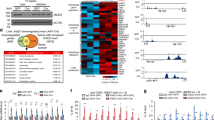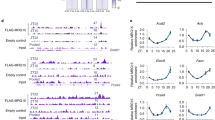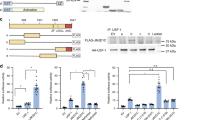Abstract
Fatty liver disease is associated with obesity and type 2 diabetes, and hepatic lipid accumulation may contribute to insulin resistance. Histone deacetylase 3 (Hdac3) controls the circadian rhythm of hepatic lipogenesis. Here we show that, despite severe hepatosteatosis, mice with liver-specific depletion of Hdac3 have higher insulin sensitivity without any changes in insulin signaling or body weight compared to wild-type mice. Hdac3 depletion reroutes metabolic precursors towards lipid synthesis and storage within lipid droplets and away from hepatic glucose production. Perilipin 2, which coats lipid droplets, is markedly induced upon Hdac3 depletion and contributes to the development of both steatosis and improved tolerance to glucose. These findings suggest that the sequestration of hepatic lipids in perilipin 2–coated droplets ameliorates insulin resistance and establish Hdac3 as a pivotal epigenomic modifier that integrates signals from the circadian clock in the regulation of hepatic intermediary metabolism.
This is a preview of subscription content, access via your institution
Access options
Subscribe to this journal
Receive 12 print issues and online access
$209.00 per year
only $17.42 per issue
Buy this article
- Purchase on Springer Link
- Instant access to full article PDF
Prices may be subject to local taxes which are calculated during checkout






Similar content being viewed by others
References
Cohen, J.C., Horton, J.D. & Hobbs, H.H. Human fatty liver disease: old questions and new insights. Science 332, 1519–1523 (2011).
Browning, J.D. & Horton, J.D. Molecular mediators of hepatic steatosis and liver injury. J. Clin. Invest. 114, 147–152 (2004).
Utzschneider, K.M. & Kahn, S.E. Review: the role of insulin resistance in nonalcoholic fatty liver disease. J. Clin. Endocrinol. Metab. 91, 4753–4761 (2006).
Nagle, C.A., Klett, E.L. & Coleman, R.A. Hepatic triacylglycerol accumulation and insulin resistance. J. Lipid Res. 50 (suppl.), S74–S79 (2009).
Postic, C. & Girard, J. Contribution of de novo fatty acid synthesis to hepatic steatosis and insulin resistance: lessons from genetically engineered mice. J. Clin. Invest. 118, 829–838 (2008).
Samuel, V.T., Petersen, K.F. & Shulman, G.I. Lipid-induced insulin resistance: unravelling the mechanism. Lancet 375, 2267–2277 (2010).
Lonardo, A., Bellentani, S., Ratziu, V. & Loria, P. Insulin resistance in nonalcoholic steatohepatitis: necessary but not sufficient—death of a dogma from analysis of therapeutic studies? Expert Rev. Gastroenterol. Hepatol. 5, 279–289 (2011).
Lass, A., Zimmermann, R., Oberer, M. & Zechner, R. Lipolysis—a highly regulated multi-enzyme complex mediates the catabolism of cellular fat stores. Prog. Lipid Res. 50, 14–27 (2011).
Donnelly, K.L. et al. Sources of fatty acids stored in liver and secreted via lipoproteins in patients with nonalcoholic fatty liver disease. J. Clin. Invest. 115, 1343–1351 (2005).
Larter, C.Z. & Yeh, M.M. Animal models of NASH: getting both pathology and metabolic context right. J. Gastroenterol. Hepatol. 23, 1635–1648 (2008).
Biddinger, S.B. & Kahn, C.R. From mice to men: insights into the insulin resistance syndromes. Annu. Rev. Physiol. 68, 123–158 (2006).
Taniguchi, C.M. et al. Divergent regulation of hepatic glucose and lipid metabolism by phosphoinositide 3-kinase via Akt and PKCλ/ζ. Cell Metab. 3, 343–353 (2006).
Leavens, K.F., Easton, R.M., Shulman, G.I., Previs, S.F. & Birnbaum, M.J. Akt2 is required for hepatic lipid accumulation in models of insulin resistance. Cell Metab. 10, 405–418 (2009).
Brown, M.S. & Goldstein, J.L. Selective versus total insulin resistance: a pathogenic paradox. Cell Metab. 7, 95–96 (2008).
Stiles, B. et al. Liver-specific deletion of negative regulator Pten results in fatty liver and insulin hypersensitivity. Proc. Natl. Acad. Sci. USA 101, 2082–2087 (2004).
Greenberg, A.S. et al. The role of lipid droplets in metabolic disease in rodents and humans. J. Clin. Invest. 121, 2102–2110 (2011).
Matsuzaka, T. et al. Crucial role of a long-chain fatty acid elongase, Elovl6, in obesity-induced insulin resistance. Nat. Med. 13, 1193–1202 (2007).
Brown, J.M. et al. CGI-58 knockdown in mice causes hepatic steatosis but prevents diet-induced obesity and glucose intolerance. J. Lipid Res. 51, 3306–3315 (2010).
Tuomilehto, J. et al. Prevention of type 2 diabetes mellitus by changes in lifestyle among subjects with impaired glucose tolerance. N. Engl. J. Med. 344, 1343–1350 (2001).
Bass, J. & Takahashi, J.S. Circadian integration of metabolism and energetics. Science 330, 1349–1354 (2010).
Desvergne, B., Michalik, L. & Wahli, W. Transcriptional regulation of metabolism. Physiol. Rev. 86, 465–514 (2006).
Feng, D. et al. A circadian rhythm orchestrated by histone deacetylase 3 controls hepatic lipid metabolism. Science 331, 1315–1319 (2011).
Panda, S. et al. Coordinated transcription of key pathways in the mouse by the circadian clock. Cell 109, 307–320 (2002).
Lawless, M.W., Norris, S., O'Byrne, K.J. & Gray, S.G. Targeting histone deacetylases for the treatment of immune, endocrine & metabolic disorders. Endocr. Metab. Immune Disord. Drug Targets 9, 84–107 (2009).
Sun, Z., Feng, D., Everett, L.J., Bugge, A. & Lazar, M.A. Circadian epigenomic remodeling and hepatic lipogenesis: lessons from HDAC3. Cold Spring Harb. Symp. Quant. Biol. published online, doi:10.1101/sqb.2011.76.011494 (6 September 2011).
Knutson, S.K. et al. Liver-specific deletion of histone deacetylase 3 disrupts metabolic transcriptional networks. EMBO J. 27, 1017–1028 (2008).
Mullican, S.E. et al. Histone deacetylase 3 is an epigenomic brake in macrophage alternative activation. Genes Dev. 25, 2480–2488 (2011).
Bell, P. et al. Evaluation of adeno-associated viral vectors for liver-directed gene transfer in dogs. Hum. Gene Ther. 22, 985–997 (2011).
Samuel, V.T. et al. Inhibition of protein kinase Cɛ prevents hepatic insulin resistance in nonalcoholic fatty liver disease. J. Clin. Invest. 117, 739–745 (2007).
Calvo, M.N. et al. PFKFB3 gene silencing decreases glycolysis, induces cell-cycle delay and inhibits anchorage-independent growth in HeLa cells. FEBS Lett. 580, 3308–3314 (2006).
Bolaños, J.P., Almeida, A. & Moncada, S. Glycolysis: a bioenergetic or a survival pathway? Trends Biochem. Sci. 35, 145–149 (2010).
Seo, Y.-K. et al. Genome-wide analysis of SREBP-1 binding in mouse liver chromatin reveals a preference for promoter proximal binding to a new motif. Proc. Natl. Acad. Sci. USA 106, 13765–13769 (2009).
Seo, Y.-K. et al. Genome-wide localization of SREBP-2 in hepatic chromatin predicts a role in autophagy. Cell Metab. 13, 367–375 (2011).
Wendel, A.A., Lewin, T.M. & Coleman, R.A. Glycerol-3-phosphate acyltransferases: rate limiting enzymes of triacylglycerol biosynthesis. Biochim. Biophys. Acta 1791, 501–506 (2009).
Brasaemle, D.L. Thematic review series: adipocyte biology. The perilipin family of structural lipid droplet proteins: stabilization of lipid droplets and control of lipolysis. J. Lipid Res. 48, 2547–2559 (2007).
Gong, J., Sun, Z. & Li, P. CIDE proteins and metabolic disorders. Curr. Opin. Lipidol. 20, 121–126 (2009).
Puri, V. et al. Fat-specific protein 27, a novel lipid droplet protein that enhances triglyceride storage. J. Biol. Chem. 282, 34213–34218 (2007).
Samuel, V.T. et al. Mechanism of hepatic insulin resistance in non-alcoholic fatty liver disease. J. Biol. Chem. 279, 32345–32353 (2004).
Hammond, L.E. et al. Mitochondrial glycerol-3-phosphate acyltransferase-1 is essential in liver for the metabolism of excess acyl-CoAs. J. Biol. Chem. 280, 25629–25636 (2005).
Nilsson, A., Thomassen, M.S. & Christiansen, E. Long-chain Acyl-CoA levels in liver from rats fed high-fat diets: is it of significance for an increased peroxisomal β-oxidation? Lipids 19, 187–194 (1984).
Mihaylova, M.M. et al. Class IIa histone deacetylases are hormone-activated regulators of FOXO and mammalian glucose homeostasis. Cell 145, 607–621 (2011).
Chang, B.H.-J. et al. Protection against fatty liver but normal adipogenesis in mice lacking adipose differentiation-related protein. Mol. Cell. Biol. 26, 1063–1076 (2006).
Imai, Y. et al. Reduction of hepatosteatosis and lipid levels by an adipose differentiation-related protein antisense oligonucleotide. Gastroenterology 132, 1947–1954 (2007).
Mutel, E. et al. Control of blood glucose in the absence of hepatic glucose production during prolonged fasting in mice: induction of renal and intestinal gluconeogenesis by glucagon. Diabetes 60, 3121–3131 (2011).
Vogt, P.K., Jiang, H. & Aoki, M. Triple layer control: phosphorylation, acetylation and ubiquitination of FOXO proteins. Cell Cycle 4, 908–913 (2005).
Zhang, W. et al. FoxO1 regulates multiple metabolic pathways in the liver: effects on gluconeogenic, glycolytic, and lipogenic gene expression. J. Biol. Chem. 281, 10105–10117 (2006).
Banks, A.S. et al. Dissociation of the glucose and lipid regulatory functions of FoxO1 by targeted knockin of acetylation-defective alleles in mice. Cell Metab. 14, 587–597 (2011).
Haeusler, R.A., Han, S. & Accili, D. Hepatic FoxO1 ablation exacerbates lipid abnormalities during hyperglycemia. J. Biol. Chem. 285, 26861–26868 (2010).
Tao, R. et al. Hepatic FoxOs regulate lipid metabolism via modulation of expression of the nicotinamide phosphoribosyltransferase gene. J. Biol. Chem. 286, 14681–14690 (2011).
Kadereit, B. et al. Evolutionarily conserved gene family important for fat storage. Proc. Natl. Acad. Sci. USA 105, 94–99 (2008).
Yang, X. et al. The G(0)/G(1) switch gene 2 regulates adipose lipolysis through association with adipose triglyceride lipase. Cell Metab. 11, 194–205 (2010).
Bell, M. et al. Consequences of lipid droplet coat protein downregulation in liver cells: abnormal lipid droplet metabolism and induction of insulin resistance. Diabetes 57, 2037–2045 (2008).
Kantartzis, K. et al. Dissociation between fatty liver and insulin resistance in humans carrying a variant of the patatin-like phospholipase 3 gene. Diabetes 58, 2616–2623 (2009).
Minehira, K. et al. Blocking VLDL secretion causes hepatic steatosis but does not affect peripheral lipid stores or insulin sensitivity in mice. J. Lipid Res. 49, 2038–2044 (2008).
Schonfeld, G., Yue, P., Lin, X. & Chen, Z. Fatty liver and insulin resistance: not always linked. Trans. Am. Clin. Climatol. Assoc. 119, 217–223, discussion 223–224 (2008).
Chang, B.H.-J., Li, L., Saha, P. & Chan, L. Absence of adipose differentiation related protein upregulates hepatic VLDL secretion, relieves hepatosteatosis, and improves whole body insulin resistance in leptin-deficient mice. J. Lipid Res. 51, 2132–2142 (2010).
Gerstein, H.C. et al. Effects of intensive glucose lowering in type 2 diabetes. N. Engl. J. Med. 358, 2545–2559 (2008).
Sapiro, J.M., Mashek, M.T., Greenberg, A.S. & Mashek, D.G. Hepatic triacylglycerol hydrolysis regulates peroxisome proliferator-activated receptor α activity. J. Lipid Res. 50, 1621–1629 (2009).
Kumashiro, N. et al. Cellular mechanism of insulin resistance in nonalcoholic fatty liver disease. Proc. Natl. Acad. Sci. USA 108, 16381–16385 (2011).
Sztalryd, C. et al. Functional compensation for adipose differentiation-related protein (ADFP) by Tip47 in an ADFP null embryonic cell line. J. Biol. Chem. 281, 34341–34348 (2006).
Acknowledgements
We thank J. Millar and the Metabolic Tracer Resource at the Penn Institute for Diabetes, Obesity and Metabolism for the lipogenesis flux assay. We thank the Mouse Metabolic Phenotyping Core and the Viral Vector Core at Penn Diabetes Research Center (P30 DK19525) and the Penn Digestives Disease Center Morphology Core (P30 DK050306) at the University of Pennsylvania. We thank the Vanderbilt (DK59637) and Yale (U24 DK059635) Mouse Metabolic Phenotyping Centers and the Children's Hospital of Philadelphia Pathology Core. We thank B. Agarwal and S. Mullican for helpful discussion. This work was supported by US National Institutes of Health grants R37 DK43806 (M.A.L.), P01 DK49210 (M.A.L., M.J. Birnbaum and R.S.A.) and R01 DK40936 (G.I.S.), R01 DK075017 (C.S.), the Department of Veteran Affairs Merit Review Program (T.G.U.), grant F32 DK079572 (R.A.M.), the JPB Foundation and the Cox Institute for Medical Research.
Author information
Authors and Affiliations
Contributions
Z.S. and M.A.L. conceived of the hypothesis and designed the experiments. Z.S., R.A.M., R.T.P., J.C., R.D., H.W. and D.Z. performed the experiments. Z.S., R.A.M., R.D., T.G.U., G.I.S., C.S., M.J. Bennett, R.S.A., M.J. Birnbaum and M.A.L. analyzed and interpreted the data. M.J.G. provided reagents. Z.S. and M.A.L. wrote the manuscript.
Corresponding author
Ethics declarations
Competing interests
The authors declare no competing financial interests.
Supplementary information
Supplementary Text and Figures
Supplementary Figures 1–8 (PDF 742 kb)
Rights and permissions
About this article
Cite this article
Sun, Z., Miller, R., Patel, R. et al. Hepatic Hdac3 promotes gluconeogenesis by repressing lipid synthesis and sequestration. Nat Med 18, 934–942 (2012). https://doi.org/10.1038/nm.2744
Received:
Accepted:
Published:
Issue Date:
DOI: https://doi.org/10.1038/nm.2744
This article is cited by
-
Dietary fat supplementation relieves cold temperature-induced energy stress through AMPK-mediated mitochondrial homeostasis in pigs
Journal of Animal Science and Biotechnology (2024)
-
What Do Higher Alanine Aminotransferase Levels Mean in Premature Ovarian Insufficiency?
Reproductive Sciences (2024)
-
Targeting protein modifications in metabolic diseases: molecular mechanisms and targeted therapies
Signal Transduction and Targeted Therapy (2023)
-
Hepatic Acat2 overexpression promotes systemic cholesterol metabolism and adipose lipid metabolism in mice
Diabetologia (2023)
-
HDAC3 inhibition protects against peripheral and central alterations in an animal model of obesity
Pharmacological Reports (2023)



